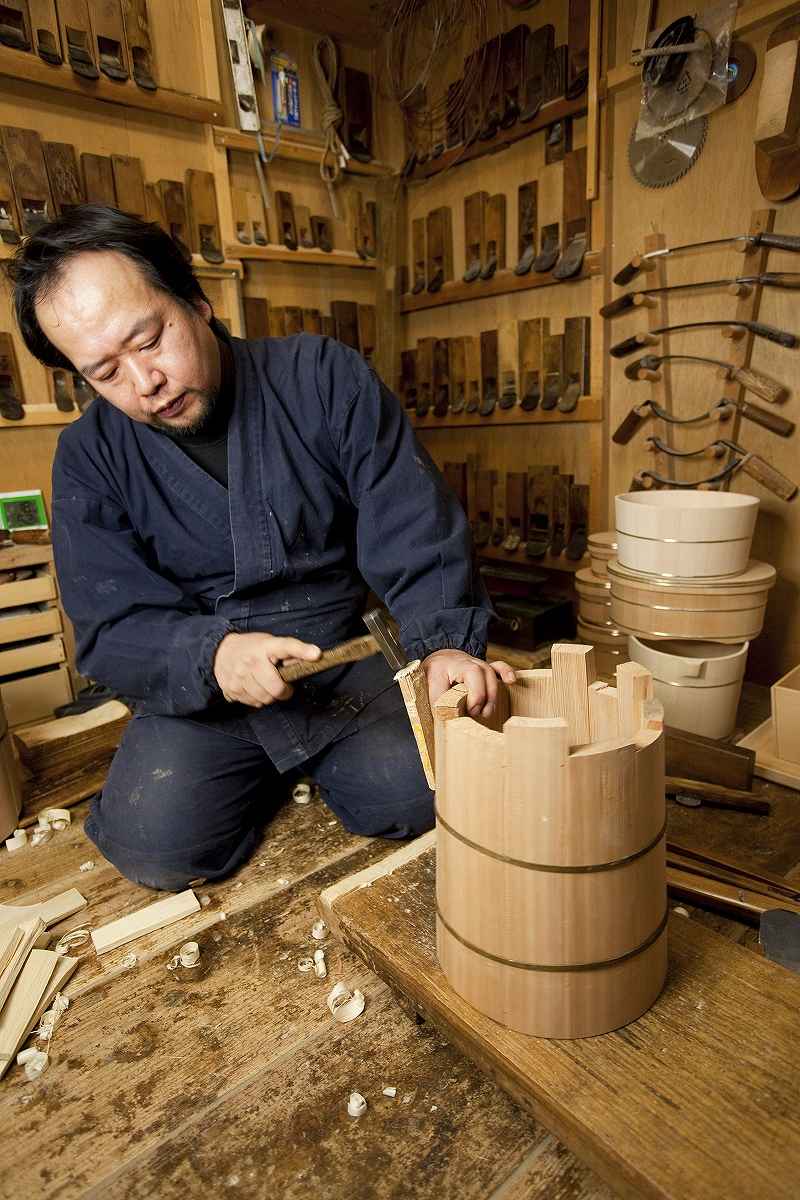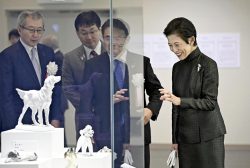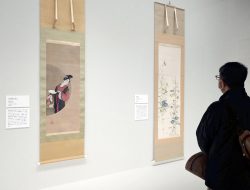Wooden Bucket Craftsman Wins Top Prize at Japan Traditional Craft Revitalization Contest; Plans to Use Techniques to Create Tearoom

Shuji Nakagawa, center, holds the Ronnie Prize at the awards ceremony for the annual Japan Traditional Craft Revitalization Contest in Tokyo on Monday.
2:00 JST, February 20, 2024
Craftsman Shuji Nakagawa, who makes ki-oke wooden buckets using 700-year-old techniques, has won the top prize in the annual Japan Traditional Craft Revitalization Contest for his innovative idea to apply long-established bucket-making methods to building a portable tearoom.
Initiated in 2021, the contest is cosponsored by JapanCraft21, a Kyoto-based nonprofit organization, and the Asia Society Japan Center, a nonprofit educational institution.
JapanCraft21, founded in 2018 by foreigners and Japanese who are keenly aware of how their encounters with Japanese craft culture have enriched their lives, has been striving to revitalize traditional Japanese master crafts by providing training and educational opportunities. As part of these efforts, the contest seeks project ideas that are expected to revitalize Japanese traditional crafts while meeting criteria such as expressing Japanese aesthetics and producing future works for younger generations.
Nakagawa, 55, a third-generation craftsman from a wooden bucket studio who runs his own studio in Shiga Prefecture, won the top prize, known as the Ronnie Prize. Concerned about the declining use of wooden buckets in everyday life in Japan, Nakagawa aspires to broaden the application of wooden bucket culture and techniques to design, arts and architecture.
Nakagawa’s goal is to ensure that traditional wooden bucket culture lasts for another century. Driven by such passion, he came up with the idea of creating a portable tearoom constructed using 700-year-old wooden bucket techniques that led to him winning the top prize.

Shuji Nakagawa handcrafts a wooden bucket at his studio in Otsu, Shiga Prefecture.
The judges praised Nakagawa’s idea, saying, for example, his concept shows that “there’s a new possibility for buckets to be used in architecture, despite the fact that they are usually considered to be small in size.”
At the award ceremony held in Tokyo on Monday, Nakagawa said: “I’d like to be an active craftsman until I die. I’ll continue to create new things and aim for a future of making better crafts.”
The award includes ¥5 million in funding and additional support for one year to realize the tearoom project.
Five other recipients of this year’s awards, individuals and duos, included artists working in the fields of textiles, fashion design, washi traditional Japanese paper, Kawara roof tiles, urushi lacquer, museum curation and silk stencil dyeing.
An exhibition featuring creations by 11 award recipients from the contests in 2022 and 2023, including Nakagawa, will be on display at the Ginza Ippodo Gallery in the Ginza district of Tokyo’s Chuo Ward from Tuesday to Sunday. The exhibition will showcase a wide variety of Japanese traditional crafts, including Kyo-hyogu art mounting, Tango Chirimen silk and Kaga Yuzen dyed fabric.
The gallery is open from 11 a.m. to 6 p.m. and requires an appointment that can be made by email or phone. Visit the gallery’s website for more information at
"Culture" POPULAR ARTICLE
-

Van Cleef & Arpels Dazzles with Art Deco Artisanry at Tokyo Exhibit
-

Disney’s ‘Twisted-Wonderland’ Animated Series Puts Villains in Spotlight: New Show Features School Inspired by Classic Disney Films
-

Japan Plans to Distribute Manga Overseas Via New Platform
-

Japanese Craftsman Produces Beautiful and Durable Bags Made of Wood
-

Ayumi Hamasaki’s Shanghai Concert Canceled Day Before Schedule as Part of Beijing Backlash
JN ACCESS RANKING
-

Keidanren Chairman Yoshinobu Tsutsui Visits Kashiwazaki-Kariwa Nuclear Power Plant; Inspects New Emergency Safety System
-

Imports of Rare Earths from China Facing Delays, May Be Caused by Deterioration of Japan-China Relations
-

University of Tokyo Professor Discusses Japanese Economic Security in Interview Ahead of Forum
-

Japan Pulls out of Vietnam Nuclear Project, Complicating Hanoi’s Power Plans
-

Govt Aims to Expand NISA Program Lineup, Abolish Age Restriction


























